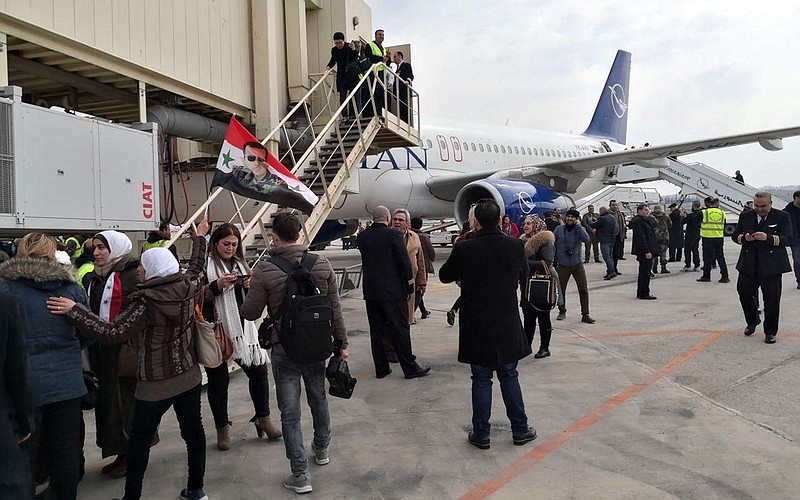ALEPPO, Syria (AP) — A Syrian passenger jet landed Wednesday in Aleppo from Damascus as domestic flights resumed between Syria’s two largest cities for the first time since 2012, while the government continued bombarding several rebel-held towns and villages nearby.
The flight carrying Syrian officials and journalists was an important symbol that President Bashar Assad’s government, with Russian military support, has consolidated its control over the northwestern province of Aleppo and also seized the last segments of the strategic M5 highway linking Aleppo to Damascus. The motorway, under repair, is scheduled to reopen in coming days for the first time in eight years.
For weeks, government forces have been conducting a military campaign to recapture the Aleppo countryside and parts of neighboring Idlib province, the last rebel-held areas in the country. The swift advances on multiple fronts have triggered the largest single wave of displacement in the nine-year civil war, with nearly 1 million people driven from their homes toward the Turkish border.
The suffering has been compounded by a bitter winter with freezing temperatures, leading to a number of deaths among people sheltering under plastic tents, in open fields and under trees. The advocacy group Save the Children reported Tuesday that seven children, including a 7-month-old, have died in cold and “horrific living conditions” in displacement camps in northwestern Syria over recent weeks.
The U.N. puts the number of civilians displaced since Dec. 1 at more than 900,000 — most of them women and children. Humanitarian chief Mark Lowcock said at least 100 civilians, 35 of them children, were killed so far in February by airstrikes and shelling. He said aid efforts are “overwhelmed.”
In New York, the U.N.’s Syria envoy, Geir Pedersen, expressed alarm at the “rapid deterioration” in Idlib, and he appealed for a cease-fire.
“Young children are dying from cold. The potential for more displacement and even more catastrophic human suffering is apparent as an increasing number of people are hemmed into an ever-shrinking space,” he told a Security Council meeting on Syria.
Satellite images showed the staggering scale of the displacement, concentrated within a small space in Idlib province near the border with Turkey.
The images from Colorado-based Maxar Technologies show a huge number of tents and shelters near Kafaldin and Deir Hassan. Images from the same area a year ago show the rapid expansion of the informal camps, as hundreds of thousands of people scrambled to escape the onslaught. The images also show tents near the edge of a nearby quarry.
Airstrikes and shelling were reported Wednesday on several rebel-held areas, mostly near Daret Azzeh and Atareb. The Britain-based Syrian Observatory for Human Rights, an opposition war monitoring group, reported more than 120 airstrikes on Tuesday alone.
The Syrian Civil Defense, an activist group, reported four civilians were killed and 18 were wounded in Tuesday’s bombardment on several parts of Idlib.
Rida Haj Bakri was among those fleeing Daret Azzeh, most of them to the areas of Afrin and Azaz. He and his family had fled to Daret Azzeh from Maaret el-Numan only about a month ago.
“The roads are filled with displaced people fleeing. … There is no water, no bread, I don’t have the price of diapers,” he said.
“I don’t know — where do we go from here?” he asked as he and his relatives packed their meager belongings onto a pickup truck.
Though Russia and Turkey support opposing sides in the conflict, the offensive has strained cooperation between Moscow and Ankara and led to clashes between Syrian and Turkish troops.
Turkey and Russia have closely coordinated their moves in recent years in Idlib province. A truce reached between the two countries collapsed in late 2019, leading to the current Russian-backed offensive.
Turkey arms and trains the Syrian opposition and has sent thousands of troops and military reinforcements into Idlib in recent weeks to try to stem the Syrian government advance. That has led to rare clashes between Turkish and Syrian troops, with deaths on both sides.
Turkish President Recep Tayyip Erdogan on Wednesday called for Assad’s forces to retreat from Idlib or face an “imminent” Turkish intervention.
“We are delivering our final warnings. We have not reached the desired results as yet,” Erdogan said, addressing lawmakers from his ruling party. “The operation in Idlib is a matter of time. We could enter (Idlib) suddenly one night.”
His comments came a day after a top Turkish official said talks in Moscow between Russian and Turkish representatives to reduce tensions in Idlib did not yield a “satisfactory result” for Ankara. The official said, however, that the sides agreed to continue discussions.

